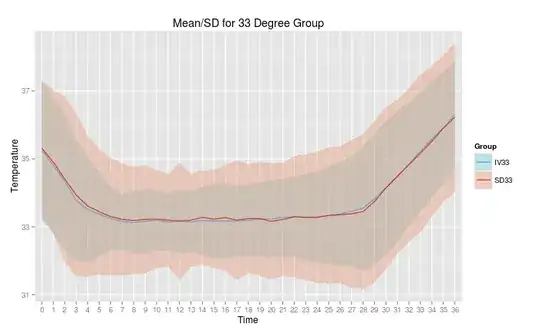I codded my PDF function for the multivariate gaussian (3D) as such:
def Gaussian3DPDF(v, mu, sigma):
N = len(v)
G = 1 / ( (2 * np.pi)**(N/2) * np.linalg.norm(sigma)**0.5 )
G *= np.exp( - (0.5 * (v - mu).T.dot(np.linalg.inv(sigma)).dot( (v - mu) ) ) )
return G
It works pretty well and it's quite fast. But I now want to fit my data to this function using a least square optimizer, and to be efficient I need to be able to pass a Mx3 matrix ( [[x0,y0,z0],[x1,...],...] )
However, my dot product will break down because now it's not 3 dot 3x3 dot 3 but 3xM dot 3x3 dot Mx3
I'm not very good with linear algebra.
Is there a trick I am not aware of ?
Thanks a lot
PS: Doing a for loop over each coordinate work but it is way way too slow for fitting on large number of data I have.
PPS: I found out about the scipy stats multivariate gaussian function. It works fine ! Though I'm still interested if anyone knows the answer ! :D
EDIT:
The code to do this in python without linear algebra:
#cube = np.array of dimention NxMxO
def Gaussian3DPDFFunc(X, mu0, mu1, mu2, s0, s1, s2, A):
mu = np.array([mu0, mu1, mu2])
Sigma = np.array([[s0, 0, 0], [0, s1, 0], [0, 0, s2]])
res = multivariate_normal.pdf(X, mean=mu, cov=Sigma)
res *= A
res += 100
return res
def FitGaussian(cube):
# prepare the data for curvefit
X = []
Y = []
for i in range(cube.shape[0]):
for j in range(cube.shape[1]):
for k in range(cube.shape[2]):
X.append([i,j,k])
Y.append(cube[i][j][k])
bounds = [[3,3,3,3,3,3,50], [cube.shape[0] - 3, cube.shape[1] - 3, cube.shape[2] - 3, 30, 30, 30, 100000]]
p0 = [cube.shape[0]/2, cube.shape[1]/2, cube.shape[2]/2, 10, 10, 10, 100]
popt, pcov = curve_fit(Gaussian3DPDFFunc, X, Y, p0, bounds=bounds)
mu = [popt[0], popt[1], popt[2]]
sigma = [[popt[3], 0, 0], [0, popt[4], 0], [0, 0, popt[5]]]
A = popt[6]
res = multivariate_normal.pdf(X, mean=mu, cov=sigma)
return mu, sigma, A, res
For linear algebra look at bellow ! Really Cool

